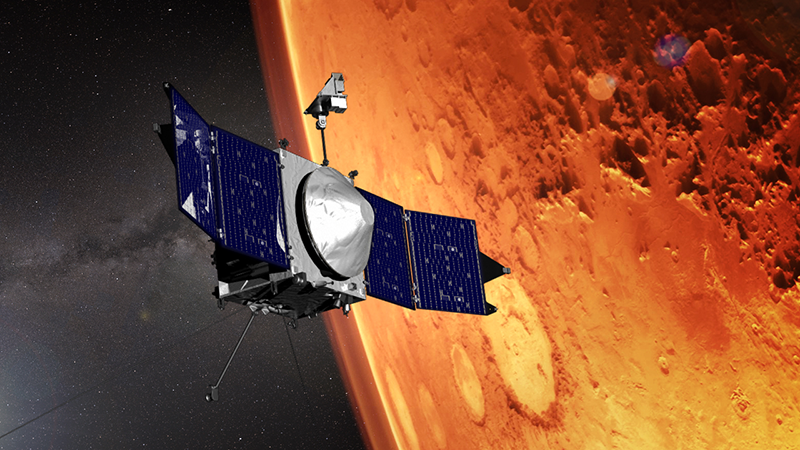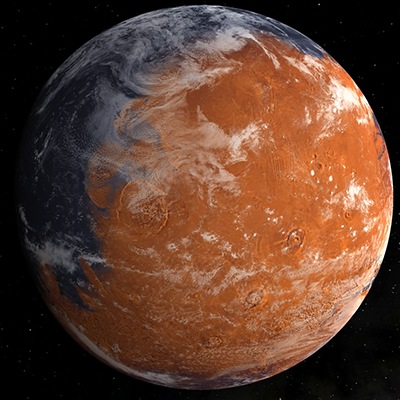
For a cold little planet, Mars remains a hot topic: The general public wants to know more about this alien world and hear from the scientists who study it. Recent findings that highlight tantalizing clues to Mars’s wetter past have piqued this interest still further.
For example, because Mars lacks a global magnetic field, the planet has lost much of its ancient, thicker atmosphere, and much of its carbon dioxide has been lost to space. How habitable was the Red Planet, and what does its history tell us about habitability of other alien worlds?
Scientists can adopt and extend many of these resources to reach another set of potential Mars science enthusiasts.The public engagement team for NASA’s Mars Atmosphere and Volatile Evolution (MAVEN) mission has developed a series of resources that use current findings from this mission to engage nonscientists in the world of Mars research. These resources have been used successfully by formal and informal educators, museum docents, and planetarium guides to captivate their respective audiences and connect them to a variety of Mars-related science topics.
Scientists can adopt and extend many of these resources to reach another set of potential Mars science enthusiasts. To help, we offer four tips to guide other groups in fully utilizing the rich outreach efforts of MAVEN.
What Is MAVEN? A Window to MarsWithout the benefit of a global magnetic field to protect it, the solar wind and the Sun’s radiation are wearing away the Martian atmosphere through a variety of mechanisms. MAVEN seeks to understand those mechanisms.
Since entering Mars orbit in September 2014, MAVEN has measured the effects of the Sun’s radiation and particles on Mars’s atmosphere and the rates at which particles are escaping into space. This mission is continuing to refine our understanding of how planets evolve over time.
 In this artist’s conception, the MAVEN spacecraft is orbiting Mars. Credit: NASA/GSFC
In this artist’s conception, the MAVEN spacecraft is orbiting Mars. Credit: NASA/GSFC
Fundamentally, the mission has determined that the erosion of Mars’s atmosphere was great enough to account for a significant change in the planet’s climate. The spacecraft is now examining how seasonal cycles and the solar cycle affect this system. The most recent results and publications from the mission can be found on the MAVEN website.
Sharing MAVEN’s ScienceAll of this research can be used to tell the story of Mars’s evolution to different audiences. In particular, the research gives the public a window into three key concepts:
Planets change over time. The Sun’s particles and radiation can affect planetary atmospheres and climate. This artist’s conception, based on Mars’s current topography, shows an early, wetter Mars with a thicker atmosphere. Credit: USRA/LPI
This artist’s conception, based on Mars’s current topography, shows an early, wetter Mars with a thicker atmosphere. Credit: USRA/LPI
Earth’s magnetic field and atmosphere have played critical roles in maintaining our habitable environment.
To help you communicate those key concepts and share the story of Mars’s changing climate, MAVEN’s public engagement team has worked out a variety of tips and resources.
1. Use Strong VisualsThe MAVEN public engagement team has created a Science on a Sphere (SOS) presentation, Invisible Mars, for use in presenting this story to general audiences. An SOS presentation is designed and scripted for a spherical projector, an effective way of demonstrating planetary features with compelling visuals.
A shorter PowerPoint version is also available, which can be modified for presentations. In addition, presenters can include a variety of videos produced by the NASA Goddard Scientific Visualization Studio.
Here’s one, “Martian Atmosphere Loss Explained,” about how MAVEN is measuring solar wind erosion at Mars, observing ions in the upper atmosphere as they pick up energy from the electric field of the solar wind and escape to space.
2. Get PersonalScientists are encouraged to add their own personal stories to more deeply connect with their audiences. Many students and adults appreciate the opportunity to get to know scientists as people, hearing about their experiences, including both failures and successes. Scientists can share their stories with live audiences, or they can make videos or podcasts to extend their reach still further.
Sharing how Mars (or evolving planetary atmospheres and solar interactions) has inspired your interests and career would provide your audience with another connection to your topic.
3. Be Hands-On“Atmospheric Pressure on Mars” uses a vacuum pump and marshmallows to demonstrate the effects of low atmospheric pressure on objects.To increase interest of younger audiences, consider incorporating some hands-on models and activities:
Red Planet lessons were created for the elementary classroom, but some activities could be useful models to include in presentations. For instance, “Atmospheric Pressure on Mars” uses a vacuum pump and marshmallows to demonstrate the effects of low atmospheric pressure on objects. Girls Go to Mars is a set of hands-on activities designed to engage middle school girls, but many of the activities can be easily adapted to use with other audiences. In the activity “How Do Atmospheres Change Over Time: The Role of Magnetosphere and Solar Wind,” participants build a simple model to demonstrate that the underlying magnetic field protects charged particles in the atmosphere from being carried away by the Sun’s magnetic field. MAVEN lessons and interactives include “Planet Designer,” an online interactive program in which audiences change features of a model of the planet to explore how the changes affect temperature and habitability. 4. Tell the Story of How Scientists Do ScienceAudiences may be interested in how MAVEN discoveries might affect future human exploration of Mars and how they relate to the future of our own planet. Scientists may also want to discuss how the solar wind and storms affect our own atmosphere and interact with Earth’s magnetic field.
 The solar wind strips electrically charged oxygen ions from Mars’s atmosphere. The most energetic ions (red) accelerate in a plume above Mars, whereas most escaping ions (green) are lost along the “tail” region. Credit: NASA/GSFC
The solar wind strips electrically charged oxygen ions from Mars’s atmosphere. The most energetic ions (red) accelerate in a plume above Mars, whereas most escaping ions (green) are lost along the “tail” region. Credit: NASA/GSFC
Scientists don’t have to be prepared to answer any and all questions related to these topics. It is more important that audiences learn how we conduct science, that investigations uncover additional questions, and that what we learn about other planets often helps us understand our own world.
Please contact the MAVEN public engagement team for further information and recommendations for specific audiences.
Author InformationChristine Shupla, Lunar and Planetary Institute, Universities Space Research Association, Houston, Texas; Karin Hauck (email: karin@ssl.berkeley.edu), Space Sciences Laboratory, University of California, Berkeley; and Tom Mason and Bruce Jakosky, Laboratory for Atmospheric and Space Physics, University of Colorado Boulder
The post Magnetic Mars Engages Lay Audiences in Science appeared first on Eos.
from Eos https://eos.org/project-updates/magnetic-mars-engages-lay-audiences-in-science?utm_source=rss&utm_medium=rss&utm_content=magnetic-mars-engages-lay-audiences-in-science
via IFTTT
